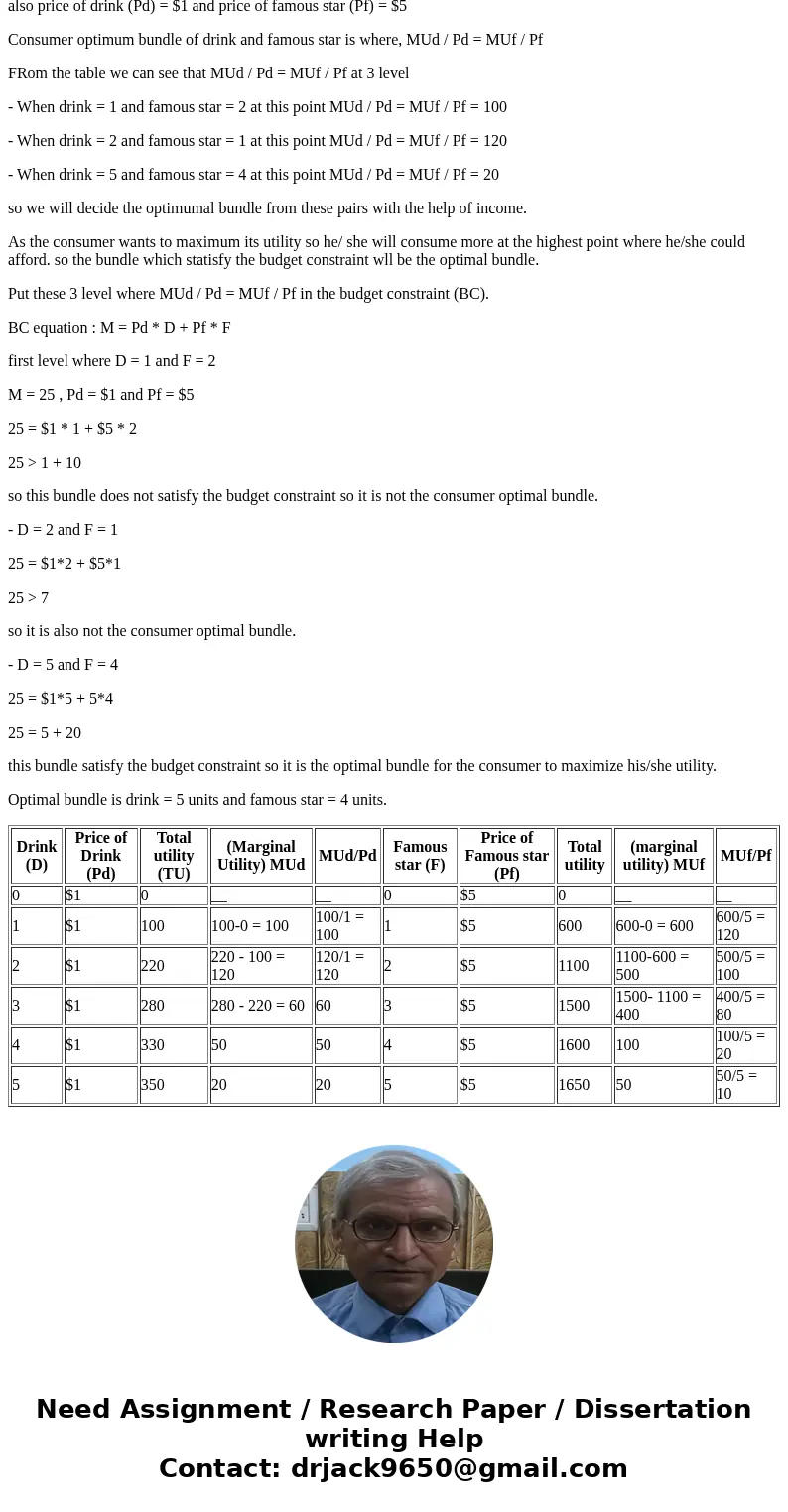You want to maximize your utility Here is your table Carls J
You want to maximize your utility. Here is your table: Carl\'s Jr. drink: $1.00 Carls\' Jr. Famous Star with cheese: $5.00 Drink Total Utility Famous Star Total Utility 0 0 0 0 1 100 1 600 2 220 2 1100 3 280 3 1500 4 330 4 1600 5 350 5 1650 if you have $25.00 in your purse/wallet, what is the Consumer Optimum?
Solution
The table is as follow here, we can find marginal utility (MU) of drink (MUd) and MU of famous star (MUf)
also price of drink (Pd) = $1 and price of famous star (Pf) = $5
Consumer optimum bundle of drink and famous star is where, MUd / Pd = MUf / Pf
FRom the table we can see that MUd / Pd = MUf / Pf at 3 level
- When drink = 1 and famous star = 2 at this point MUd / Pd = MUf / Pf = 100
- When drink = 2 and famous star = 1 at this point MUd / Pd = MUf / Pf = 120
- When drink = 5 and famous star = 4 at this point MUd / Pd = MUf / Pf = 20
so we will decide the optimumal bundle from these pairs with the help of income.
As the consumer wants to maximum its utility so he/ she will consume more at the highest point where he/she could afford. so the bundle which statisfy the budget constraint wll be the optimal bundle.
Put these 3 level where MUd / Pd = MUf / Pf in the budget constraint (BC).
BC equation : M = Pd * D + Pf * F
first level where D = 1 and F = 2
M = 25 , Pd = $1 and Pf = $5
25 = $1 * 1 + $5 * 2
25 > 1 + 10
so this bundle does not satisfy the budget constraint so it is not the consumer optimal bundle.
- D = 2 and F = 1
25 = $1*2 + $5*1
25 > 7
so it is also not the consumer optimal bundle.
- D = 5 and F = 4
25 = $1*5 + 5*4
25 = 5 + 20
this bundle satisfy the budget constraint so it is the optimal bundle for the consumer to maximize his/she utility.
Optimal bundle is drink = 5 units and famous star = 4 units.
| Drink (D) | Price of Drink (Pd) | Total utility (TU) | (Marginal Utility) MUd | MUd/Pd | Famous star (F) | Price of Famous star (Pf) | Total utility | (marginal utility) MUf | MUf/Pf |
|---|---|---|---|---|---|---|---|---|---|
| 0 | $1 | 0 | __ | __ | 0 | $5 | 0 | __ | __ |
| 1 | $1 | 100 | 100-0 = 100 | 100/1 = 100 | 1 | $5 | 600 | 600-0 = 600 | 600/5 = 120 |
| 2 | $1 | 220 | 220 - 100 = 120 | 120/1 = 120 | 2 | $5 | 1100 | 1100-600 = 500 | 500/5 = 100 |
| 3 | $1 | 280 | 280 - 220 = 60 | 60 | 3 | $5 | 1500 | 1500- 1100 = 400 | 400/5 = 80 |
| 4 | $1 | 330 | 50 | 50 | 4 | $5 | 1600 | 100 | 100/5 = 20 |
| 5 | $1 | 350 | 20 | 20 | 5 | $5 | 1650 | 50 | 50/5 = 10 |


 Homework Sourse
Homework Sourse